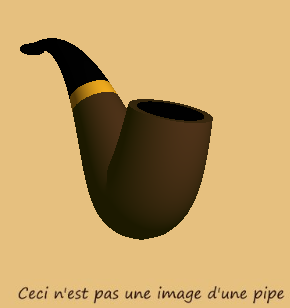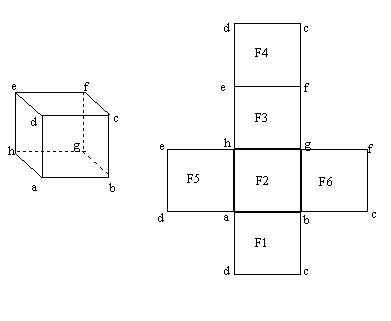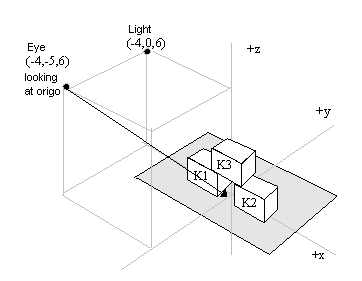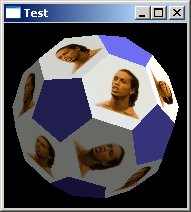
JOGL>Pipe
Pipe
Geometry

The pipe is described by three cubic Bezier functions, and the drawing is made using Frenet Frames [2] .
The main pipeshape is described with an axis in YZ-plane, and the ovals describing the thickness along the main outline is described with two Beziers, one for X and one for Y.
_init
bezier bezierZ=new bezier(
new v3d(1f,4.0f,0f),
new v3d(1f,-4.5f,2.5f),
new v3d(1f,8.5f,3.5f),
new v3d(1f,6.0f,8.0f));
bezier bezierX=new bezier(
new v3d(1.5f,0f,0f),
new v3d(2.1f,0f,0f),
new v3d(0.4f,0f,0f),
new v3d(0.3f,0f,0f));
bezier bezierY=new bezier(
new v3d(0f,1.5f,0f),
new v3d(0f,2.1f,0f),
new v3d(0f,0.4f,0f),
new v3d(0f,0.1f,0f));v3d is a simple utility class for handling vectors, crossproduct, matrixmultiplication etc.
The bezierfunctions are handled with a simple class:
_bezier.java
package pipe;
/**
* Handling a Bezier function and its derivative
* @author bs
*/
public class bezier {
v3d p0,p1,p2,p3;
public bezier(v3d P0,v3d P1,v3d P2,v3d P3)
{
p0=P0;p1=P1;p2=P2;p3=P3;
}
/**
* Calculate a position for a given parameter t [0..1]
* @param t The parameter t
* @return A point as a vector
*/
public v3d B(float t){
return new v3d(
p0.x*(-t*t*t + 3*t*t - 3*t + 1)+
p1.x*(3*t*t*t - 6*t*t + 3*t)+
p2.x*(-3*t*t*t + 3*t*t)+
p3.x*(t*t*t),
p0.y*(-t*t*t + 3*t*t - 3*t + 1)+
p1.y*(3*t*t*t - 6*t*t + 3*t)+
p2.y*(-3*t*t*t + 3*t*t)+
p3.y*(t*t*t),
p0.z*(-t*t*t + 3*t*t - 3*t + 1)+
p1.z*(3*t*t*t - 6*t*t + 3*t)+
p2.z*(-3*t*t*t + 3*t*t)+
p3.z*(t*t*t));
}
/**
* Calculate a value of the derivative for a given parameter t [0..1]
* @param t The parameter t
* @return A vector
*/
public v3d dB(float t){
return new v3d(
p0.x*(-3*t*t + 6*t - 3)+
p1.x*(9*t*t - 12*t + 3)+
p2.x*(-9*t*t + 6*t)+
p3.x*(3*t*t),
p0.y*(-3*t*t + 6*t - 3)+
p1.y*(9*t*t - 12*t + 3)+
p2.y*(-9*t*t + 6*t)+
p3.y*(3*t*t),
p0.z*(-3*t*t + 6*t - 3)+
p1.z*(9*t*t - 12*t + 3)+
p2.z*(-9*t*t + 6*t)+
p3.z*(3*t*t));
}
}
The points and the normals on the pipebody is calculated as Frenet Frames. The method that generates the pipeshape is:
_construct
BUF=FloatBuffer.allocate((RCOUNT+2)*(ZCOUNT+2)*3);
NBUF=FloatBuffer.allocate((RCOUNT+2)*(ZCOUNT+2)*3);
BUF.rewind();
NBUF.rewind();
float bigt=0.0f;
// all bands along the pipebody
for(int zix=0;zix<ZCOUNT;zix++)
{
// where is it
v3d C=bezierZ.B(bigt);
// finding the normalized tangent
// here in yz-plane
v3d Z=bezierZ.dB(bigt).normalize();
// finding a second vector, use x
v3d X=new v3d(1.0f,0.0f,0.0f).normalize();
// finding a third vector
v3d Y=Z.cross(X).normalize();
// setting up the matix that will take us to the
// Frenet frame located at this t-point
// M=|X,Y,Z,C|, where C is the Bezier itself
// note transpose of matrix
float M[]={
X.x,X.y,X.z,0,
Y.x,Y.y,Y.z,0,
Z.x,Z.y,Z.z,0,
C.x,C.y,C.z,1};
// do the ellipse
float v=0.0f;
v3d xp=bezierX.B(bigt);
v3d yp=bezierY.B(bigt);
// doing the ellipse
for(int vix=0;vix <= RCOUNT;vix++)
{
float xv=(float)(xp.x*Math.cos(v));
float yv=(float)(yp.y*Math.sin(v));
v3d p=new v3d(xv,yv,0).matmult(M);
//points
BUF.put(p.x);
BUF.put(p.y);
BUF.put(p.z);
// generate normals
NBUF.put(p.x-C.x);
NBUF.put(p.y-C.y);
NBUF.put(p.z-C.z);
v+=rstep;
}
bigt+=zstep;
}We use the buffered data to draw the shape
_draw
BUF.rewind();
NBUF.rewind();
int roundCount=RCOUNT+1;
setBrownMaterial(gl);
gl.glBegin(GL.GL_QUAD_STRIP);
int offset=0;
for(int zix=1;zix < BROWNCOUNT; zix++)
{
offset=roundCount*zix*3;
for(int rix=0;rix <roundCount;rix++)
{
gl.glNormal3fv(NBUF.array(), offset-roundCount*3+(rix)*3);
gl.glVertex3fv(BUF.array(), offset-roundCount*3+(rix)*3);
gl.glNormal3fv(NBUF.array(), offset+rix*3);
gl.glVertex3fv(BUF.array(), offset+rix*3);
}
}
gl.glEnd();
setBrassMaterial(gl);
gl.glBegin(GL.GL_QUAD_STRIP);
for(int zix=BROWNCOUNT-1;zix < BRASSCOUNT;zix++)
{
offset=roundCount*zix*3;
for(int rix=0;rix <roundCount;rix++)
{
gl.glNormal3fv(NBUF.array(), offset-roundCount*3+(rix)*3);
gl.glVertex3fv(BUF.array(), offset-roundCount*3+(rix)*3);
gl.glNormal3fv(NBUF.array(), offset+rix*3);
gl.glVertex3fv(BUF.array(), offset+rix*3);
}
}
gl.glEnd();
setBlackMaterial(gl);
gl.glBegin(GL.GL_QUAD_STRIP);
for(int zix=BRASSCOUNT;zix < ZCOUNT;zix++)
{
offset=roundCount*zix*3;
for(int rix=0;rix <roundCount;rix++)
{
gl.glNormal3fv(NBUF.array(), offset-roundCount*3+(rix)*3);
gl.glVertex3fv(BUF.array(), offset-roundCount*3+(rix)*3);
gl.glNormal3fv(NBUF.array(), offset+rix*3);
gl.glVertex3fv(BUF.array(), offset+rix*3);
}
}
gl.glEnd();













